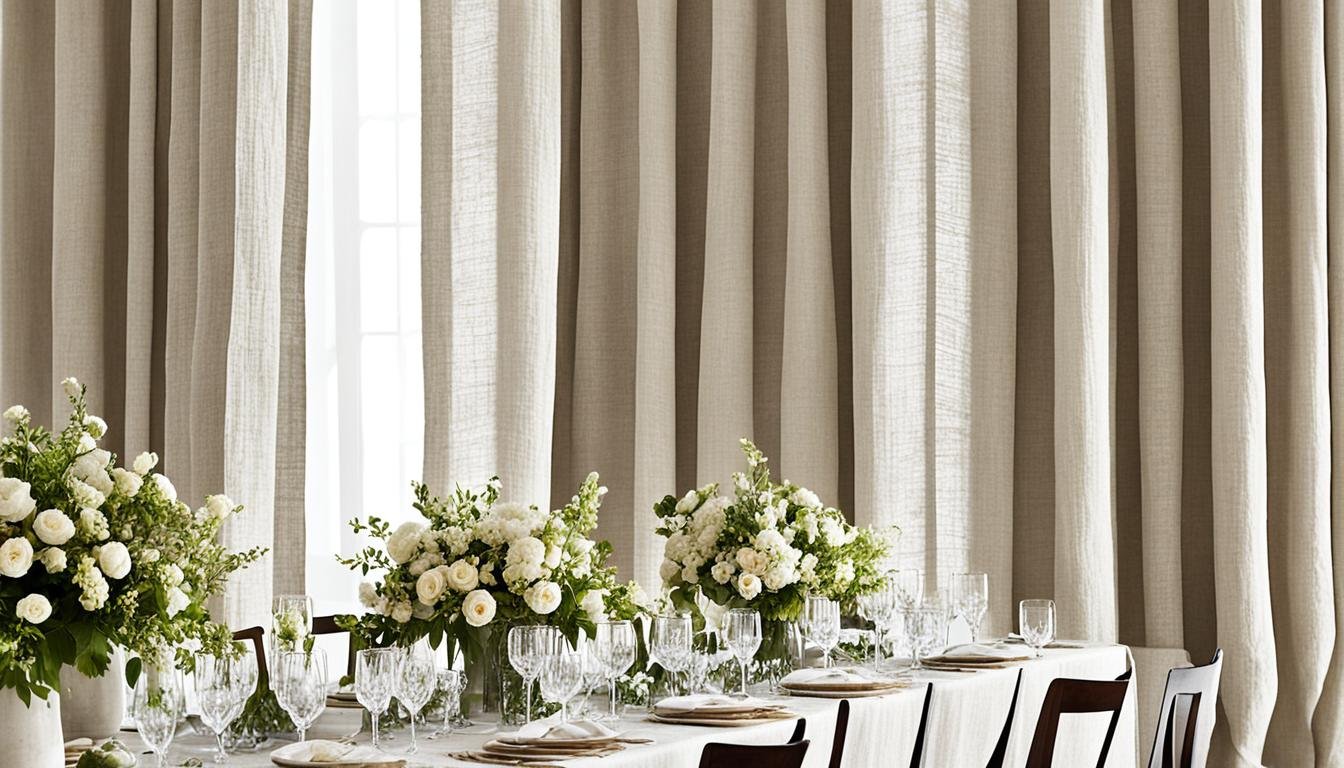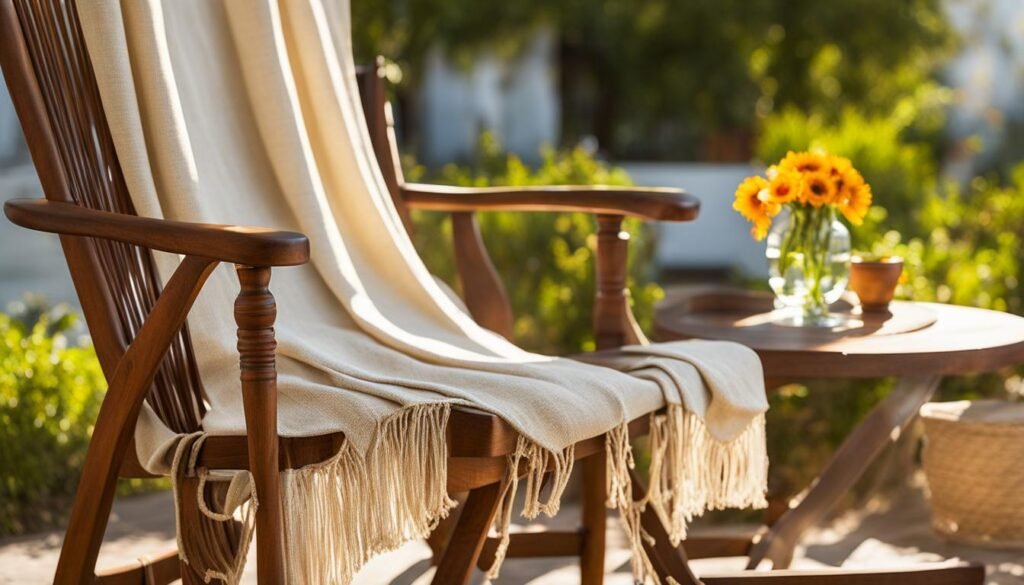Your cart is currently empty!

Linen Fabric Traits: Breathable & Timeless Elegance
Delving into the world of fashion textiles, one encounters a myriad of materials, yet few possess the enduring appeal and linen qualities that resonate through time. Infused with grace and functionality, linen stands out as a luxury textile celebrated for its breathable materials and chic versatility. This sustainable fabric has clothed generations, providing cool comfort with its exceptional linen characteristics that meet the needs of modern sustainability and timeless style.
Anchored deeply in history with roots tracing back to ancient Egypt, linen has pioneered durability in the realm of fashion textiles. It has nestled itself securely in the annals of fashion, providing a lightweight, breathable, and comfortable option that transcends the seasons. The cultivation of linen, hailing from the resilient flax plant, underscores a commitment to sustainable fabrics, with its water-conserving growth process aligning perfectly with today’s eco-conscious mien.
Key Takeaways
- Linen fabric retains breathability, providing comfort and elegance in fashion.
- Its enduring qualities extend from ancient civilizations to present-day luxury.
- The sustainable cultivation process underlines linen’s eco-friendly profile.
- Diverse in application, linen merges with other fibres for varied textures.
- Hypoallergenic and antibacterial, linen is a healthy choice for any wardrobe.
- Strength and minimal care ensure linen’s status as a durable textile choice.
The Rich Heritage and Production of Linen
The lineage of linen, with its beginnings in the cradle of civilization, is as storied as the cultures that cherished it. Across the sun-drenched landscapes of the Mediterranean, flax cultivation blossomed, weaving a narrative that threads through the heart of ancient textiles and into the lush fields of modern sustainable agriculture. Today, linen cultivation stands as a symbol of eco-friendly textile production, honoring a rich heritage of linen while embracing environmentally conscious practices.
From Ancient Egypt to Modern Day: The Timeless Journey of Linen
The annals of history bear testament to the integral role of linen in Mediterranean trade, gracing the markets of bustling Phoenician cities, adorning Roman patricians, and preserving the eternal slumber of Egyptian pharaohs. A testament to its luxury apparel status, this venerated fabric heralds a rich heritage that endures, undiluted, mirroring its own unyielding fibres.
Organic Cultivation: How the Flax Plant Becomes Linen
Bound to the earth, the sturdy flax plant surges forth with slender stalks, harboring within its fibers the essence of organic fibers. Organic cultivation methods preserve its integrity, requiring no synthetic assistants, ensuring every step from soil to loom adheres to the pillars of sustainable agriculture. This mindful approach to linen cultivation not only promises a fabric kind to earth and skin but also echoes a historical reverence for nature’s offerings.
The Making of Linen: From Plant to Elegant Fabric
Transforming flax into linen is an art, honed over millennia yet unchanged in its essence. Harvested with care, the flax undergoes the age-old practices of retting and weaving, emerging as one of the most durable materials known to man. This labor-intensive alchemy gives rise to the luxury garments and high-quality textiles that continue to grace our lives, embodying an elegance forged by time and tenacity.
- Linen’s enduring presence in both ancient textiles and modern fashion resonates with those seeking luxury apparel.
- The commitment to organic fibers and sustainable agriculture highlights the sustainable aspects of linen cultivation.
- Fabric production involves a meticulous process, showcasing the handcrafted quality of this revered textile.
- Linen’s robust nature inherently lends itself to the creation of durable materials, appreciated in both historical and contemporary contexts.
- The versatility of the natural vegetable fibers provides a canvas for luxury garments and a plethora of high-quality textiles.
As we piece together the past and present of linen, it’s clear that the fabric’s narrative is interwoven with innovation, sustainability, and an unwavering commitment to quality. It is the choice textile for those who seek comfort without compromising elegance, and for those dedicated to fostering an eco-conscious future.
Properties of Linen Fabric
The quintessential attributes of linen fabric have long been venerated for their natural proficiency in enhancing wellbeing and comfort through innovative fibers. Its dynamic fusion of style and functionality encompasses a wealth of properties, pivotal to its reputation as an elite textile choice.
Known for its thermal regulation, linen is inherently adaptive to varying temperatures, making it an excellent companion throughout the changing seasons. Its capacity for moisture-wicking is equally impressive, quickly absorbing perspiration and providing continuous dryness and comfort.
Contributing to its coveted status, linen garners acclaim for its UV protection, safeguarding the skin against harsh solar rays. This inherent defense mechanism, coupled with antimicrobial fabric properties, establishes a barrier against microorganisms, thereby reducing unwanted odors and fostering a sensation of freshness.

Moreover, linen’s hypoallergenic fabric is a balm for sensitive skin, offering a gentle touch that diminishes the risk of allergies and skin irritation. This aligns with a growing consumer emphasis on skin-friendly apparel.
Below is a breakdown of the linen fabric’s beneficial features which contribute to its universal appeal across a variety of applications:
| Property | Description | Benefits |
|---|---|---|
| Thermal Regulation | Hollow fibers that adjust to body temperature | Comfort in various climates, preservation of body comfort |
| Moisture-Wicking | High absorbency, swift moisture release | Keeps skin dry, enhances comfort |
| UV Protection | Natural protection against sun rays | Contributes to skin health, reduces sun damage |
| Antimicrobial | Natural resistance to bacteria and fungi | Prevents odor, maintains garment freshness |
| Hypoallergenic | Minimizes risk of allergies and skin irritation | Ideal for sensitive skin |
Standing at the intersection of tradition and technology, linen fabric advances with its unparalleled fusion of features, ensuring it retains its esteemed stature within the textile industry for both its health and environmental benefits.
Conclusion
In closing, linen fabric presents itself not merely as a material, but as a testament to timeless elegance and sustainability. From the golden fields of flax to the wardrobes of the environmentally conscious fashionista, linen has walked a path of distinction and durability. It graces our lives with its versatility, serving as the fabric of choice for everything from luxury bedding to breezy summer attire. As we embrace the natural textures of this storied textile, we tap into a lineage of quality and tradition that enriches our daily experiences.
Natural textiles like linen empower consumers to make sustainable choices without compromising on luxury or style. The myriad advantages of this high-quality linen add tangible value to a variety of products while aligning with the principles of an eco-friendly lifestyle. Whether draped across a bed in the form of sumptuous sheets or tailored into chic apparel, linen endures as the quintessential selection for those who covet both comfort and refined taste.
Ultimately, the embrace of linen is more than a nod to aesthetics; it is a commitment to a legacy of environmental stewardship and enduring class. As we look towards the future of fashion and home decor, linen stands as a beacon among natural textiles, inviting us to partake in the sheer magnificence of a fabric that has been cherished for millennia. In the fabric of our lives, the thread of linen weaves a narrative of elegance, functionality, and responsible consumption—proof that true style never falters, and the best choices are those that serve both our desires and the well-being of our planet.
FAQ
What makes linen fabric such a sought-after material for fashion and textiles?
Linen fabric is prized for its natural breathability, durability, and an elegant allure that makes it a versatile choice for clothing and home textiles. Its sustainability and luxurious feel have made it a favorite in high-quality fashion and eco-friendly fabric choices.
Can you trace linen back to its historical origins?
Linen fabric has its origins rooted in ancient Egypt, valued for mummy wrappings and as a symbol of wealth. It was a centerpiece in Mediterranean trade due to its strength and sophistication, with records dating back to 7000 BC in places like Çatalhöyük, Turkey.
Why is linen considered an eco-friendly and sustainable fabric?
Linen is made from the flax plant, which requires minimal water and grows organically without the need for pesticides or fertilizers. Its production is virtually waste-free, and it compares favorably to other crops, like cotton, in terms of environmental impact.
How is linen produced from the flax plant?
The process includes harvesting flax, followed by retting (the process of breaking down the fibers), and then weaving the cellulose fibers into linen fabric. This process is labor-intensive and contributes to the higher value of linen in the market compared to more industrial fabrics.
What are the benefits of wearing linen clothing, especially in warm climates?
Linen’s hollow fibers allow for significant airflow, making it one of the most breathable materials. This provides excellent heat regulation and moisture-wicking capabilities, perfect for warm climates as it gives a feeling of freshness and comfort while also offering UV protection due to its tightly woven fibers.
Does linen offer any health benefits?
Yes, linen is hypoallergenic and possesses antibacterial properties, making it a good choice for people with sensitivities or allergies. It does not cling to the skin when sweating and dries quickly, which can prevent bacterial growth and skin irritations.
How does blending linen with other fabrics like cotton or viscose affect its properties?
Blending linen with cotton or viscose can alter its texture and thickness, providing designers and consumers with varied options. These blends can offer a balance between the rigidity of pure linen and the softness and elasticity of other fibers, creating fabrics that maintain many of linen’s desirable properties while adding to its versatility.
Is linen suitable for all types of garments and home textiles?
Absolutely. The timeless elegance and exceptional properties of linen make it suitable for a wide range of products, including luxurious clothing, sumptuous bedding, and elegant home textiles. Its versatility and enduring appeal ensure it remains a fabric of choice for both sustainability and style.
Leave a Reply